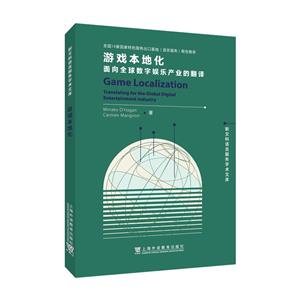【目录】
Figures and tables
Acknowledgements
About this book
Aim and structure of the book
Target readers
Conventions used in this book
Glossary
Prologue
Introduction
Rationale
Context
An overview of translation studies research trajectoriesin game localization
General trends in game localization research
Key research areas
Approach
CHAPTER 1
The video game and translationIntroduction
1.1 A historical sketch of video game localization
1.1.1 Early days:Before the mid-1980s
1.1.2 Growth phase:The mid-1980s to mid-1990s
1.1.3 Development phase:The mid-to late 1990s
1.1.4 Maturing phase:Early 2000 to 2005
1.1.5 Advancing phase:2005 to the present
1.2 Video games:Domain,terminology and characteristics
1.2.1 Key terminology:Video game vs.computer game
1.2.2 Defining a video game
1.2.3 Game genres
1.2.4 Video games as transmedia
1.2.5 Video game theory:Narative theory versus play theory
1.3 The structure of the video game industry
CHAPTER 2
The localization paradigm:Localization versus translationIntroduction
2.1 Software localization defined by practice:Internationalization
2.2 New dimensions of localization
2.2.1 Cultural representations and adaptation requiredin software localization
2.2.2 Localization facilitated by technology
2.3 Localization in Translation Studies
2.4 Game localization or game translation?
2.5 An absence of agency in localization speak
CHAPTER 3
Game localization:A practical dimension Introduction
3.1 Video games and GILT:Localization-friendly game development
3.2 Game localization models
3.2.1 Outsourcing model
3.2.2 In-house model
3.3 Game assets requiring localization
3.3.1 In-game text
3.3.2 Art assets
3.3.3 Audio and cinematic assets
3.3.4 Printed materials
3.4 The localization process
3.4.1 Pre-localization
3.4.2 Translation
3-4.3 Editing
3.4.4 Recording
3.4.5 Post-localization
3.4.6 Submission of release candidate version
3.4.7 Production and distribution
3.4.8 Game localization scenario
3.5 Levels of localization
3.6 Tools used in game translation
CHAPTER 4
Translating video games:New vistas for transcreationIntroduction
4.1 Game text taxonomy and text function
4.1.1 Game text:Play and narrative dimensions
4.1.2 Game text taxonomy and translation
4.2 Translation strategies applied in game localization
4.2.1 Translation strategies for pragmatic translation problems
4.2.2 Translation strategies for interlingual translation problems
4.3 A brief case study of Square Enix
4.3.1 Overview
4-3.2 Examples of innovation and appropriation of translation
4.4 The translator as a creative agent:Game localization as transcreation
4.4.1 Internal knowledge versus external knowledgeas professional norms versus expectancy norms
4.4.2 Translator's agency and transcreation
CHAPTER 5
Cultural contexts of game production:Patronage and rewritingin the digital age
Introduction
5.1 Video games as cultural products
5.1.1 Game culture:Japan versus the US
5.1.2 Cultural content in games and cultural localization
5.2 Cultural adjustments
5.2.1 Mandatory requirements for change
5.2.2 Market-driven adjustments:Market relevance and preferences
5.3 Culture of game production:Power game
5.4 Game localization as rewriting
CHAPTER 6
Pedagogical issues in training game localizersIntroduction
6.1 Game localization as an emerging professional translation activity
6.2 Training future game localizers
6.2.1 Game localizers competence
6.2.2 Course design
6.2.3 Assessment
6.3 Teaching materials and human resources
6.3.1 The eCoLoMedia game localization course
6.4 Pedagogy in game localization:A vocational or an academic focus?
CHAPTER 7
Game localization research in Translation StudiesIntroduction
7.1 Game localization and accessibility research
71.1 Game accessibility and accessibility barriers in video games
71.2 Benefits of game accessibility
7.1.3 Research on game accessibility
7.2 Game localization and fan studies:Fans as co-creators
7.2.1 Fan culture represented in the form of fan work
7.2.2 Fan translation:Translation hacking and crowdsourcing
7.2.3 Fan translator expertise versus professional expertise
7.3 A new research direction in Translation Studies:User-focusedempirical research
73.1 Player experience studies
73.2 Natural language interaction through AI,chatbot,and speech recognition
Conclusion
Game localization,game translation or game transcreation?
Translation quality and users
Localization directionality and regional variations of language International game design and internationalization Technology applications and the future of game localization
References
Gameography
APPENDIX
Postgraduate courses in game localization in Spain
Index





















